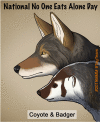March Mammal Madness and the power of narrative in science outreach
- PMID: 33616530
- PMCID: PMC7899649
- DOI: 10.7554/eLife.65066
March Mammal Madness and the power of narrative in science outreach
Abstract
March Mammal Madness is a science outreach project that, over the course of several weeks in March, reaches hundreds of thousands of people in the United States every year. We combine four approaches to science outreach - gamification, social media platforms, community event(s), and creative products - to run a simulated tournament in which 64 animals compete to become the tournament champion. While the encounters between the animals are hypothetical, the outcomes rely on empirical evidence from the scientific literature. Players select their favored combatants beforehand, and during the tournament scientists translate the academic literature into gripping "play-by-play" narration on social media. To date ~1100 scholarly works, covering almost 400 taxa, have been transformed into science stories. March Mammal Madness is most typically used by high-school educators teaching life sciences, and we estimate that our materials reached ~1% of high-school students in the United States in 2019. Here we document the intentional design, public engagement, and magnitude of reach of the project. We further explain how human psychological and cognitive adaptations for shared experiences, social learning, narrative, and imagery contribute to the widespread use of March Mammal Madness.
Keywords: animal behavior; animal ecology; ecology; education; genetics; genomics; human; informal learning; outreach; performance science; science communication.
© 2021, Hinde et al.
Conflict of interest statement
KH, CA, AB, NB, AC, TC, PC, MD, CD, JD, LD, AH, EK, MK, JK, JK, DL, KL, KL, JL, JM, AM, WN, AN, AP, SS, AS, BT, JW, MW, EW, CA No competing interests declared, MC, CH, OP, VP All revenue generated by the sale of tournament artwork through the Society6 shop (<ext-link ext-link-type="uri" xlink:href="https://society6.com/mammalmadness">https://society6.com/mammalmadness</ext-link>) is equitably divided among the artistic team. JD is an employee of BE Creative LLC. BE is the owner of BE Creative LLC.
Figures











Similar articles
-
Promoting public engagement in interdisciplinary biological systems education by leveraging American sports-inspired bracket contests on social media and web.J Microbiol Biol Educ. 2024 Aug 29;25(2):e0007824. doi: 10.1128/jmbe.00078-24. Epub 2024 Jul 16. J Microbiol Biol Educ. 2024. PMID: 39012128 Free PMC article.
-
Integrative approaches to dispersing science: A case study of March Mammal Madness.Am J Hum Biol. 2022 Feb;34 Suppl 1:e23659. doi: 10.1002/ajhb.23659. Epub 2021 Aug 6. Am J Hum Biol. 2022. PMID: 34358377
-
The Manchester Fly Facility: Implementing an objective-driven long-term science communication initiative.Semin Cell Dev Biol. 2017 Oct;70:38-48. doi: 10.1016/j.semcdb.2017.06.004. Epub 2017 Jun 15. Semin Cell Dev Biol. 2017. PMID: 28624601 Review.
-
Rethinking Giftedness and Gifted Education: A Proposed Direction Forward Based on Psychological Science.Psychol Sci Public Interest. 2011 Jan;12(1):3-54. doi: 10.1177/1529100611418056. Psychol Sci Public Interest. 2011. PMID: 26168418
-
The droso4schools project: Long-term scientist-teacher collaborations to promote science communication and education in schools.Semin Cell Dev Biol. 2017 Oct;70:73-84. doi: 10.1016/j.semcdb.2017.07.025. Epub 2017 Jul 23. Semin Cell Dev Biol. 2017. PMID: 28746842 Review.
Cited by
-
Darwinian genomics and diversity in the tree of life.Proc Natl Acad Sci U S A. 2022 Jan 25;119(4):e2115644119. doi: 10.1073/pnas.2115644119. Proc Natl Acad Sci U S A. 2022. PMID: 35042807 Free PMC article.
-
Promoting public engagement in interdisciplinary biological systems education by leveraging American sports-inspired bracket contests on social media and web.J Microbiol Biol Educ. 2024 Aug 29;25(2):e0007824. doi: 10.1128/jmbe.00078-24. Epub 2024 Jul 16. J Microbiol Biol Educ. 2024. PMID: 39012128 Free PMC article.
References
-
- Able KW. Natural history: an approach whose time has come, passed, and needs to be resurrected. ICES Journal of Marine Science. 2016;73:2150–2155. doi: 10.1093/icesjms/fsw049. - DOI
-
- Agosto V, Karanxha Z, Unterreiner A, Cobb-Roberts D, Esnard T, Wu K, Beck M. Running bamboo: a mentoring network of women intending to thrive in academia. NASPA Journal About Women in Higher Education. 2016;9:74–89. doi: 10.1080/19407882.2015.1124785. - DOI
-
- Akerman K, Willing T. An ancient rock painting of a marsupial lion, Thylacoleo carnifex, from the Kimberley, Western Australia. Antiquity. 2009;83:1–4.
-
- Archer J, Hillsdale NJ, Huntingford F. Game theory models and escalation of animal fights. In: Potegal M, Knutson J. F, editors. The Dynamics of Aggression. Lawrence Erlbaum Associates, Inc; 1994. pp. 3–31. - DOI
MeSH terms
LinkOut - more resources
Full Text Sources
Other Literature Sources

